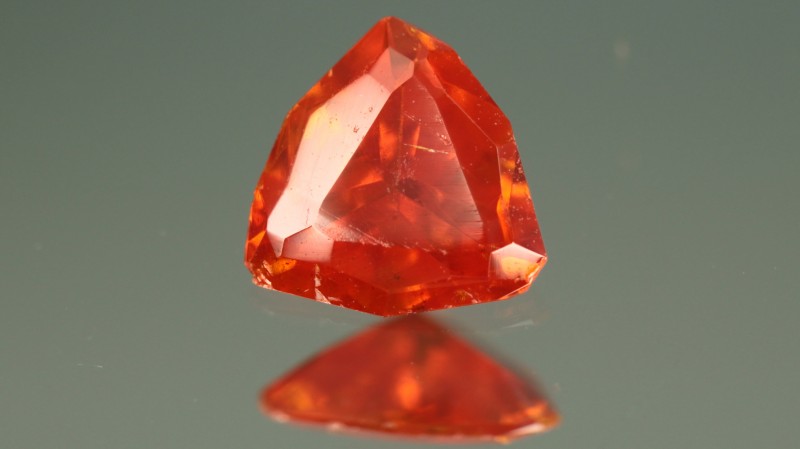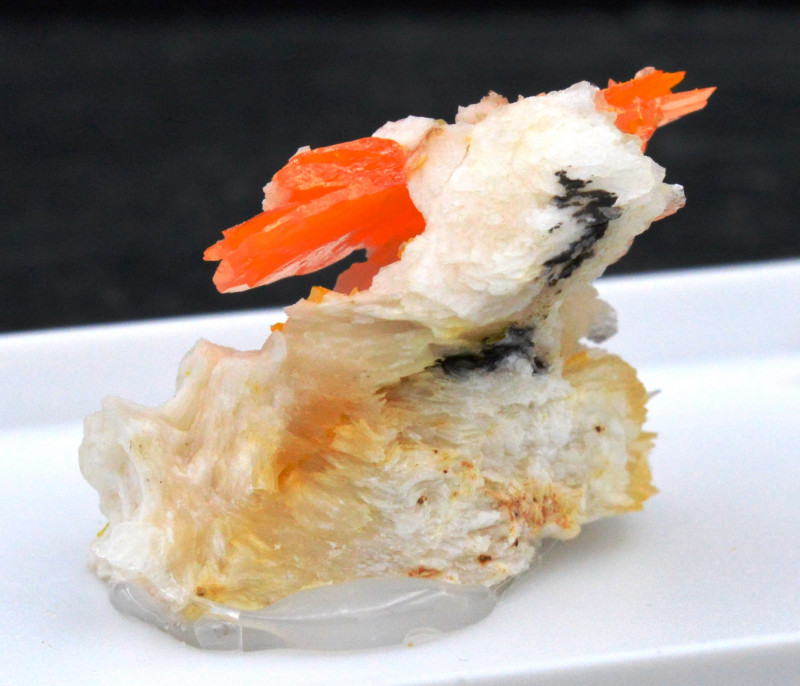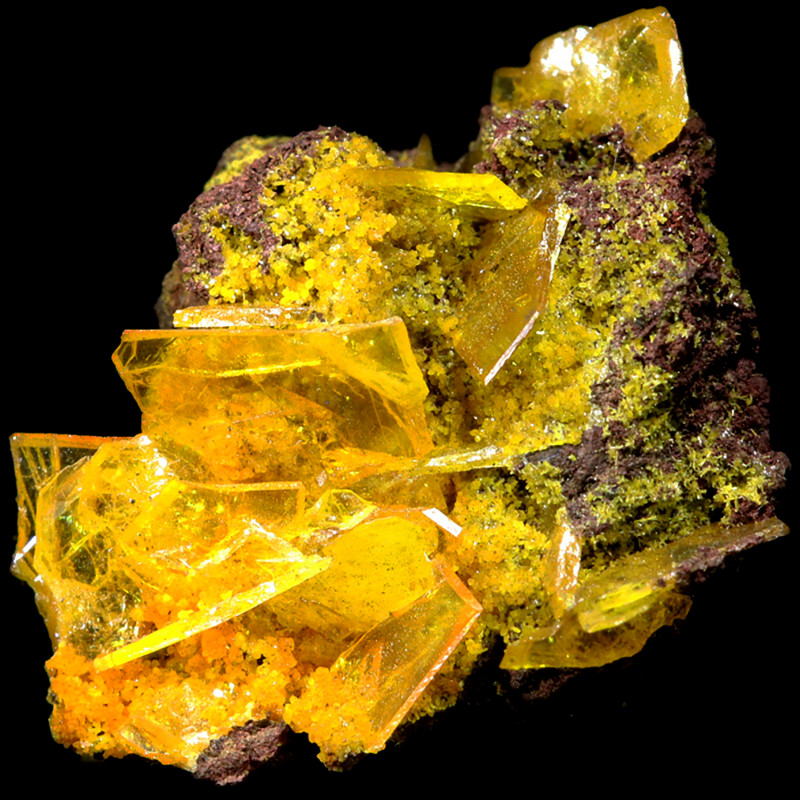
Wulfenite Gemstone: Properties, Meanings, Value & More
 Wulfenite is a commonly bright orange to yellow gemstone most notably known from Arizona, USA. The stone serves as Arizona’s official state mineral and was even the theme for the 65th annual Tucson Gem and Mineral Show in 2019.
Wulfenite is a commonly bright orange to yellow gemstone most notably known from Arizona, USA. The stone serves as Arizona’s official state mineral and was even the theme for the 65th annual Tucson Gem and Mineral Show in 2019.
Is wulfenite rare or common? The mineral is somewhat uncommon, though it does come from quite a few locales. However, gem-quality crystals that are thick enough to cut into gems are exceedingly rare.
The wulfenite stone is better known as a collector’s stone, partly for its rarity but also because its natural formations are so unique and beguiling.
Interested in learning more before browsing some wulfenite for sale? In this guide, we’ll break down everything you need to know about wulfenite gemstones, including their price, appearance, healing powers, and more.

About Wulfenite Stone
Wulfenite is a semi-precious gemstone that’s also known as “yellow lead ore.” It’s a zodiac stone for Sagittarius and the 7 life path number in numerology.
This stone is one of few minerals containing molybdenum. Molybdenum doesn’t occur naturally on its own, but rather always as part of a compound.
Besides gems, what is the wulfenite mineral used for? For many years, wulfenite was mined as a molybdenum ore, though this isn’t its only industrial benefit.
Because molybdenum is strong and resistant to weathering when combined with other metals, additional wulfenite uses include wet processing (a process for separating ores from their host), oil refining, and steel strengthening (when combined with iron).
On the mineral side of things, what mineral is wulfenite?
Wulfenite Specifications & Characteristics
Wulfenite is a lead molybdate mineral. The mineral’s formula is PbMoO4. It joins other molybdenum minerals like molybdenite and powellite. Wulfenite also forms a series with the much rarer stolzite (PbWO4), with wulfenite on the molybdate-dominant end and stolzite on the tungsten-dominant end.
What does wulfenite look like? Wulfenite has warm orange, yellow, or red hues. Its unique shapes include pyramidal or bipyramidal (two pyramids attached at the base) shapes, along with thin tabular crystals or granular masses.
Besides its autumnal colors, wulfenite’s luster is a stand-out feature. The luster can be adamantine, like that of diamond, to resinous, like that of amber. Wulfenite also has a high refractive index, meaning lots of light passes through it.
Another unique trait of wulfenite is that some specimens are piezoelectric, meaning they generate an electrical charge under mechanical pressure. Because its density is high, it’ll feel heavier than other crystals of the same size (dimensionally).
Here are the remaining mineral properties of wulfenite:
Mohs hardness: 2.5-3
Color: Shades of orange, yellow, brownish-orange, red, tan, brown, yellow-gray, greenish-brown, olive green, black, colorless
Crystal structure: Tetragonal
Luster: Adamantine (diamond-like) or resinous
Transparency: Transparent to opaque
Refractive index: 2.28-2.40
Density: 6.5-7.0
Cleavage: Distinct, 1-direction
Fracture: Irregular/uneven to subconchoidal
Streak: White
Luminescence: None
Pleochroism: Present but weak in orange and yellow
Birefringence: 0.122
Now, what does wulfenite mean symbolically? And when was it first discovered?

Wulfenite Meaning & History
Wulfenite symbolizes passion, vitality, and past lives. In spiritual circles, wulfenite is a popular crystal for ritual work and acquiring the knowledge and wisdom from one’s past lives.
Wulfenite was first officially described in 1845 by Austrian mineralogist Wilhelm Karl von Haidinger, who studied specimens from Bad Bleiberg in Carinthia, Austria.
Before Haidinger’s description, Enlightenment scientist Ignaz Edler von Born called the stone "plumbum spatosum flavo-rubrum, ex Annaberg, Austria.” Austrian scientist Joseph Franz von Jacquin also proposed the name “Kärntherischer bleispath” which is German for “Carinthian lead path.” Another former name was “melinose” after the Greek meli for “honey” in reference to its honey-like color.
Haidinger chose the name “wulfenite” to honor another Austrian mineralogist and botanist Franz Xaver von Wulfen. Wulfen is well known for exploring and reporting on the botany of the Eastern Alps. You may see other instances of names honoring Wulfen, such as the Wulfenia and Wulfeniopsis plant genuses, along with over 20 other plants with scientific names containing wulfenii.
If Wulfen is mostly associated with plants, why does this mineral honor him? Well, Wulfen was a man of many passions, including mineralogy, and he notably published research on lead ores from Carinthia in 1785.
Wulfenite was mined pretty consistently throughout the 1800s and into the 20th century for its molybdenum content. However, this changed around the 1950s when mining operations focused on getting molybdenum from molybdenite instead, as molybdenite was easier to mine.
That said, many folks still prize wulfenite. As recently as 2017, the state of Arizona (USA) designated wulfenite as its state mineral.
Another group that loves wulfenite is crystal healers!

Wulfenite Healing Properties
Like all gemstones, wulfenite’s color influences its powers as a healing stone. Red wulfenite crystals, like other red gemstones, bring qualities of energy and motivation. Orange wulfenites evoke the orange gemstone benefits of creativity and intimacy, while yellow wulfenites join other yellow gemstones in promoting joy and intellectual curiosity.
Next, we’ll look at wulfenite’s physical, emotional, and chakra healing benefits.
Physical Healing
Physically, wulfenite is said to help with:
Low sex drive
Healing post-childbirth
Low appetite
Low metabolism
Indigestion
Spleen issues
Crystal healers particularly recommend wulfenite to treat health problems for women.
Emotional Healing
If you struggle with getting the energy or motivation to get work done, wulfenite is the stone for you. The crystal is said to ignite perseverance and enhance focus, giving you the motivation to accomplish any task with confidence.
Additionally, wulfenite is believed to clear the mind and lift your spirit. If you have a project you’ve been wanting to pursue, especially in a creative field, meditating with wulfenite can help you plan out the path to make that dream a reality.
Chakra Healing
Chakra healing involves opening or balancing particular energy centers (chakras) along your body, each of which governs various aspects of wellness. Wulfenite is a chakra stone for harmonizing the sacral and solar plexus chakras.
The sacral chakra governs our emotions and intimacy, while the solar plexus chakra rules creativity and willpower. You can use wulfenite to bring them into greater balance and symbiosis, allowing you to bring your daydreams to fruition.
You know its value for healing, but what makes wulfenite valuable as a gemstone?

Wulfenite Gemstone Properties
Wulfenite’s value comes from its gemstone properties, or value factors, based on the categories of color, cut, clarity, and carat weight, along with if it’s synthetic or natural.
Color
Wulfenite is allochromatic, meaning its pure form is colorless. However, colorless wulfenite is rare. Usually, impurities or inclusions create new colors, the most common being shades of orange, yellow, or red. Less often, specimens may be blue, brown, green, or black.
Yellow to red colors likely come from chromium impurities, though some theorize that molybdate is responsible for yellow hues. Some specimens show different colors on different sides, such as brown on one side and red on the other.
The lush red wulfenites are usually most valuable.
Cut
Wulfenite’s low ranking on the Mohs mineral hardness scale, brittle tenacity, and typically thin crystals make faceted cuts quite difficult. Most wulfenite crystals are simply too thin to facet at all, making the rare faceted specimens incredibly valuable.
More often, wulfenite crystals or specimens are sold in their raw state, uncut.
Clarity
Wulfenite crystals almost always contain inclusions, as these give the stone its coloration. Some interesting inclusions or impurities include black manganese crystals, red mimetite spheres, and thin, black descloizite blades.
Any wulfenite crystal with no visible inclusions is rare and incredibly valuable.
Carat Weight
The size range of wulfenites somewhat depends on their coloring. Yellow or orange wulfenites are rare over 2 carats, while red wulfenites are rare over 1 carat.
Namibia is the only source for larger gems, with faceted examples over 50 carats, but the amount of facetable Namibian material is still scarce. Arizona has produced material yielding faceted gems as large as 5 carats.
The largest currently known wulfenite is a yellow, 56-carat specimen from Namibia.
Synthetics
While labs haven’t enhanced wulfenites, they have created synthetic wulfenite gems. The two processes used for creating these stones are the flux and pull methods, though you can also weld molybdite to cerussite to create synthetic wulfenite.
Synthetic wulfenites are mostly used industrially, but they’re also sold for jewelry and decor purposes. Natural material is almost always more valuable than synthetic material, though.
Speaking of natural material, how does wulfenite form?

Wulfenite Formation & Sources
Wulfenite is a secondary mineral, meaning it forms when primary minerals (formed inside rocks as the rocks formed) become altered. The alteration method is mostly oxidation of lead minerals, as you’ll typically see wulfenite in the higher, oxidized areas of hydrothermal lead veins.
Miners also commonly find wulfenite in igneous rock cavities beside other lead minerals like pyromorphite, galena, cerussite, and vanadinite (to name a few). In England, wulfenite crystals often form in magnesium-rich limestone.
Mining Locations
Where is wulfenite found? Wulfenite has a few different sources. The main sources are known for producing distinctly colored wulfenite. Red Cloud Mine in the state of Arizona, USA, is perhaps the best known locale, producing high-quality, deep red crystals.
One Mexican locale, Los Lamentos, is notable for its thick orange wulfenite crystals. Meanwhile, Mount Peca, Slovenia, is a great source for butterscotch yellow pyramidal wulfenite crystals on white calcite.
Additional, smaller wulfenite sources include:
Algeria
The Alps (Europe)
Australia
Austria
Chile
China
Czechia
DR of Congo
England
Germany
Italy
Morocco
Namibia
Poland
Republic of the Congo
Slovakia
Slovenia
USA (California, Colorado, Massachusetts, Montana, Nevada, New Mexico, Pennsylvania, Utah, Washington)

Wulfenite Price & Value
Wulfenite’s rarity means its prices are fairly steep. Faceted wulfenite gemstones are the rarest and most valuable option, fetching up to $725 per carat. The average range for 0.5- to 1-carat faceted wulfenite gems is $45-$270 per carat.
Raw wulfenite is much more affordable. The average wulfenite price per gram is $2.50-20 per gram (or $0.50-$4 per carat) at wholesale prices. However, rough, translucent wulfenite crystals with bright orange coloring can be closer to $20 per carat.
Wulfenite Care and Maintenance
First, let’s discuss safety. As a lead mineral, is wulfenite dangerous? Polished or fashioned wulfenite is safe to handle. Rough material should be handled with gloves. Never drink elixirs made by soaking wulfenite.
Onto gemstone care, this stone is quite soft, so any wulfenite jewelry should have protective settings. Even copper coins can scratch wulfenite’s surface, so be sure to store and transport it away from other materials.
The stone is also sensitive to vibration and heat, so special care should be taken when handling the stone. It’s better suited for display than jewelry wear.
Because dust contains quartz particles, which rank at 7 on the Mohs scale, do not wipe wulfenite’s surface to clean it. The safest method is to gently pat the surface with a soft, dust-free, microfiber cloth.
Store wulfenite stones in a dark, cool area that isn’t susceptible to shaking or vibrations.

Feeling Wooed by Wulfenite?
Wulfenite has some impressive gemstone qualities, from its diamond-like luster to its vibrant and unique autumn coloring. Beyond that, this crystal is perfect for igniting your passion and giving you that push you need to make your daydreams a reality.
Search the Gemstone Encyclopedia
Related Auctions
Related Articles
Originally the Birthstones or gemstones were associated with a zodiac sign or the month of a individuals birth. Find out what your stone is and view the stones we have for sale
8th Feb 2021
There are dozens of quartz and chalcedony gems with various colors and patterns. Learn all about quartz properties and every type of quartz, from amethyst and agate to plasma and phantom quartz!
15th Oct 2020
Hackmanite is a pink to violet sodalite gem known for its unique color-change and luminescence. Learn why hackmanite is special, from its rare qualities to the types of hackmanite jewelry available.
28th Mar 2018
Latest Articles
Catapleiite is a lesser-known mineral and rare gemstone often found as stunning tabular rosettes near other rare stones. Discover the history, prices, benefits, and properties of catapleiite!
28th Apr 2025
Yugawaralite is a rare colorless, white, or pinkish zeolite crystal named for its discovery in Yugawara, Japan. Here we uncover the multifaceted history, properties, prices, and uses of yugawaralite.
24th Mar 2025
Simpsonite is a lesser-known mineral known on the gem market for its durability, yellow-orange color, and rarity. Discover all the properties, uses, prices, and history of simpsonite.
3rd Mar 2025
Article Categories
How To's is where you will find helpful articles from gem Rock Auctions on how to cut gemstones, select gemstones and buy gemstones.
9 Articles





